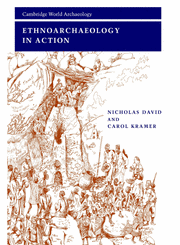Book contents
- Frontmatter
- Dedication
- Contents
- List of figures and credits
- List of tables
- Preface
- Acknowledgments
- Map
- 1 Ethnoarchaeology: its nature, origins, and history
- 2 Theorizing ethnoarchaeology and analogy
- 3 Fieldwork and ethics
- 4 Human residues: entering the archaeological context
- 5 Fauna and subsistence
- 6 Studying artifacts: functions, operating sequences, taxonomy
- 7 Style and the marking of boundaries: contrasting regional studies
- 8 Settlement: systems and patterns
- 9 Site structures and activities
- 10 Architecture
- 11 Specialist craft production and apprenticeship
- 12 Trade and exchange
- 13 Mortuary practices, status, ideology, and systems of thought
- 14 Conclusions: ethnoarchaeology in context
- Bibliography
- Index
8 - Settlement: systems and patterns
Published online by Cambridge University Press: 05 March 2015
- Frontmatter
- Dedication
- Contents
- List of figures and credits
- List of tables
- Preface
- Acknowledgments
- Map
- 1 Ethnoarchaeology: its nature, origins, and history
- 2 Theorizing ethnoarchaeology and analogy
- 3 Fieldwork and ethics
- 4 Human residues: entering the archaeological context
- 5 Fauna and subsistence
- 6 Studying artifacts: functions, operating sequences, taxonomy
- 7 Style and the marking of boundaries: contrasting regional studies
- 8 Settlement: systems and patterns
- 9 Site structures and activities
- 10 Architecture
- 11 Specialist craft production and apprenticeship
- 12 Trade and exchange
- 13 Mortuary practices, status, ideology, and systems of thought
- 14 Conclusions: ethnoarchaeology in context
- Bibliography
- Index
Summary
… none but the largest! Kung dry-season camps would be found by the future archaeologist.
(John Yellen 1977a: 80)Some of these sites were surprisingly large.
(Lewis Binford 1983a: 133 regarding Nunamiut activity areas)… mobility among foragers is not only the result of techno-economic decisions or energetic variables … it is also the consequence of a myriad factors, psychological, social, historical and ideological.
(Gustavo Politis 1996: 500–1)This chapter is concerned with ethnoarchaeological contributions to understanding of subsistence-settlement systems, the broad patterns of interaction between demography, economic adaptations, and the environment that result in distribution across the landscape of interrelated sites of varying importance and function. We take a traditional (but not evolutionary) approach, treating studies of hunter-gatherer settlement before ones relating to pastoralists and cultivators. The chapter concludes by discussing contrasts and the concepts of mobility and sedentism.
Settlement patterns and subsistence-settlement systems
Settlements often leave substantial tangible remains on landscapes, and evidence of what their occupants cultivated, gathered, hunted, bred, and ate is also often preserved. It is on the basis of site types and associated remains of plants and animals that archaeologists make provisional identifications of subsistence adaptations, which are often subsumed under such overly broad categories as “hunter-gatherer” or “farmer.” Archaeologists are interested in the closely interrelated matters of subsistence and settlement for many reasons.
- Type
- Chapter
- Information
- Ethnoarchaeology in Action , pp. 225 - 254Publisher: Cambridge University PressPrint publication year: 2001



